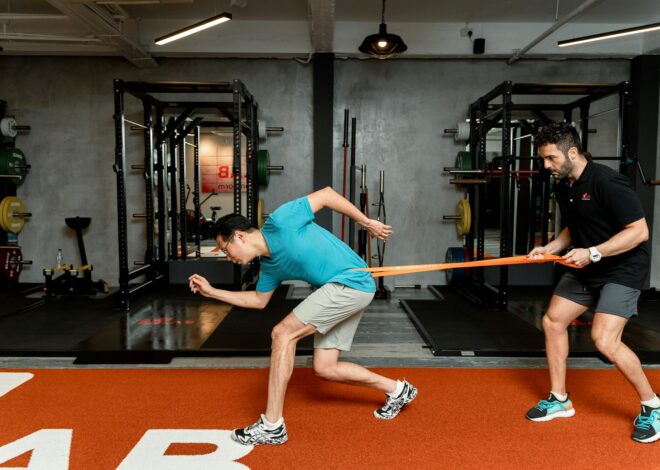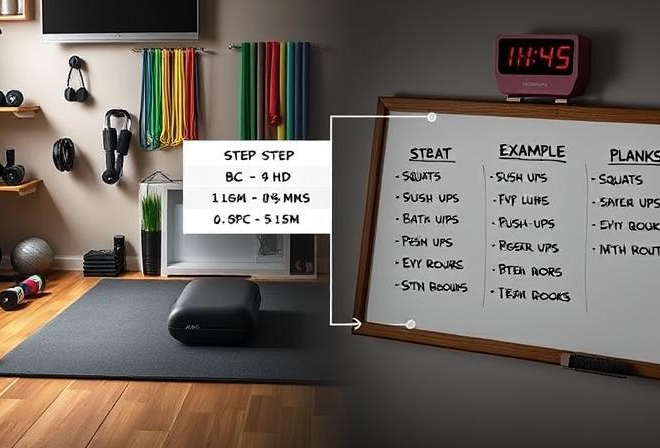
Strength Training for Women: How to Lift Weights and Build Confidence
Benefits of Strength Training for Women
Strength training offers numerous benefits for women of all ages and fitness levels. One of the key advantages is improved muscle strength and endurance, which can help in performing daily activities more efficiently and reduce the risk of injuries. Additionally, strength training can enhance metabolism, leading to better calorie burning even at rest, which can be beneficial for weight management and overall health.
Moreover, engaging in regular strength training can help women develop lean muscle mass, resulting in a toned and sculpted physique. This can boost self-confidence and body image, promoting a positive relationship with one’s physical appearance. Furthermore, strength training has been shown to increase bone density, which is especially crucial for women as they age to prevent osteoporosis and maintain skeletal health.
Common Misconceptions about Women and Weightlifting
Many women may fear that weightlifting will make them bulky or masculine, but this is a common misconception. In reality, women do not have enough testosterone to build large, bulky muscles like men unless they are specifically training to do so. Strength training actually helps women achieve a toned and lean physique by increasing muscle definition and boosting metabolism.
Another misconception is that weightlifting is dangerous for women and can lead to injury. While it’s true that improper form or lifting weights that are too heavy can increase the risk of injury, following proper technique and starting with lighter weights can help women safely reap the benefits of strength training. Strength training is not only safe for women, but it can also improve overall strength, balance, and bone density, ultimately reducing the risk of injury in daily activities.
Choosing the Right Weights for Your Strength Training Routine
When it comes to selecting the appropriate weights for your strength training routine, it is important to find a balance between challenging yourself and maintaining proper form. Starting with lighter weights is often recommended for beginners to focus on mastering the movements and reducing the risk of injury. As you become more comfortable with the exercises, gradually increase the weight to continue challenging your muscles and promoting growth. Listen to your body and pay attention to how it responds to different weights to determine the intensity that works best for you.
Avoid the temptation to choose weights that are too heavy from the start, as this can hinder your progress and increase the likelihood of straining muscles. Conversely, using weights that are too light may not provide enough resistance to effectively engage your muscles. Finding the right balance is key to seeing improvements in strength and muscle tone. Remember, it’s not just about the numbers on the weights, but also about how effectively you can perform the exercises with proper technique and control.
Essential Warm-Up Exercises Before Lifting Weights
It is crucial to prioritize warming up properly before diving into a weightlifting session to prevent injuries and optimize performance. Dynamic stretching can help increase blood flow to the muscles and improve flexibility. Incorporating movements like arm circles, leg swings, and hip rotations can help prepare your body for the demands of lifting weights. These dynamic warm-up exercises can also help activate the muscles you will be targeting during your workout, ensuring they are ready for the load they will bear.
In addition to dynamic stretching, performing light cardio activities such as jogging in place or jumping jacks can raise your body temperature and get your heart rate up. This gradual increase in intensity can help prepare your cardiovascular system for the workout ahead. Including mobility exercises that target specific areas where you may have tightness or restrictions can also help improve your range of motion and prevent injury during weightlifting. By incorporating a comprehensive warm-up routine, you can set yourself up for a successful and safe strength training session.
Proper Form and Technique for Weightlifting
When performing weightlifting exercises, maintaining proper form and technique is crucial to not only maximize the effectiveness of the workout but also to prevent injuries. One key aspect of proper form is to ensure that your body alignment is correct throughout the movement. For example, keeping your back straight and core engaged can help protect your spine during exercises like deadlifts or squats.
In addition to alignment, it is important to focus on controlled and deliberate movements rather than relying on momentum to lift the weight. This not only targets the specific muscles you are aiming to work but also reduces the risk of strains or sprains. Remember to breathe evenly and avoid holding your breath during the lifting phase of the exercise. By paying attention to these details and practicing good form consistently, you can make the most out of your weightlifting routine while minimizing the risk of injury.
Incorporating Compound Movements into Your Workout
Compound movements are exercises that engage multiple muscle groups and joints simultaneously. They are highly effective for building overall strength and enhancing functional fitness. Incorporating compound movements into your workout routine can maximize your time at the gym by targeting multiple areas of the body in each exercise. Examples of compound movements include squats, deadlifts, bench presses, and pull-ups.
By incorporating compound movements into your workout, you can challenge your body in new ways, leading to increased muscle growth and improved coordination. These exercises also help improve your balance and stability, which are essential for performing daily activities with ease. Whether you are a beginner or a seasoned lifter, incorporating compound movements into your routine can take your strength training to the next level and help you achieve your fitness goals more efficiently.
The Importance of Progressive Overload in Strength Training
Progressive overload is a fundamental principle in strength training that involves gradually increasing the demands placed on the muscles in order to stimulate growth and adaptation. This can be achieved by lifting heavier weights, performing more repetitions, or increasing the intensity of your workouts over time. By consistently challenging your muscles with progressively higher levels of resistance, you can continue to experience gains in strength and muscle mass.
Without the implementation of progressive overload, your muscles can plateau and adapt to the current level of stress, leading to a halt in progress. It is important to periodically reassess your strength training routine and make adjustments to ensure that you are continually challenging your muscles to adapt and grow stronger. Whether you are a beginner or experienced lifter, incorporating progressive overload into your workouts is key to achieving your fitness goals and maximizing the benefits of your strength training routine.
Balancing Cardio and Strength Training in Your Fitness Routine
Cardio and strength training are both crucial components of a well-rounded fitness routine for women. While cardio exercises like running, cycling, or aerobic classes are great for improving cardiovascular health, burning calories, and enhancing endurance, strength training plays a vital role in building lean muscle mass, increasing metabolism, and strengthening bones. Balancing both forms of exercise in your fitness regimen can help you achieve a harmonious blend of cardiovascular fitness, muscular strength, and overall health.
It’s important to strike a balance between cardio and strength training based on your individual fitness goals. Some women may prefer focusing more on cardio for weight loss or endurance purposes, while others may prioritize strength training to build muscle and increase overall strength. Tailoring the ratio of cardio to strength training in your routine can help you achieve the desired results and maintain a well-rounded approach to fitness. Remember that variety is key to keeping your workouts engaging and effective, so don’t hesitate to mix up your routine with a combination of cardio and strength exercises to keep your body challenged and progressing.
• When balancing cardio and strength training, consider your individual fitness goals
• Some may focus more on cardio for weight loss or endurance, while others prioritize strength training for muscle building
• Tailor the ratio of cardio to strength training in your routine to achieve desired results
• Variety is important in keeping workouts engaging and effective
• Mix up your routine with a combination of cardio and strength exercises for optimal results
Nutrition Tips for Women Who Lift Weights
Nutrition plays a crucial role in supporting women’s strength training goals. Consuming an adequate amount of protein is essential for building and repairing muscles. Including sources such as lean meats, poultry, fish, eggs, dairy products, legumes, and tofu in your diet can help meet your protein needs. Additionally, carbohydrates are important for providing energy during workouts. Opt for complex carbs like whole grains, fruits, vegetables, and legumes to fuel your workouts and aid in muscle recovery.
Incorporating healthy fats into your diet is also crucial for overall health and hormone regulation. Nuts, seeds, avocados, and olive oil are excellent sources of healthy fats that can support optimal performance and recovery. Staying hydrated is equally important, so make sure to drink enough water throughout the day, especially before, during, and after your strength training sessions. Proper hydration can help maintain performance levels, prevent fatigue, and support muscle function.
How to Set Realistic Goals for Your Strength Training Journey
Setting realistic goals for your strength training journey is crucial for staying motivated and making progress. Begin by defining clear and specific objectives that are measurable and attainable within a reasonable timeframe. Whether you aim to increase your lifting capacity, improve muscle tone, or enhance overall strength, specificity is key in setting achievable goals. Avoid vague statements and instead focus on tangible outcomes that you can track and celebrate as you progress.
It’s important to consider both short-term and long-term goals when mapping out your strength training journey. Short-term goals can help you stay focused and motivated on a day-to-day basis, while long-term goals provide direction and purpose for your overall progress. By breaking down your ultimate objectives into smaller, manageable milestones, you can create a roadmap for success and track your development over time. Remember to adjust your goals as you evolve in your training, allowing flexibility to accommodate changes in your strength, endurance, and overall fitness levels.
The Role of Rest and Recovery in Building Muscle
Rest and recovery play a crucial role in building muscle effectively. When we engage in strenuous strength training workouts, our muscles undergo stress and micro-tears. It is during the rest period that these tears repair and muscles grow stronger and bigger. Without adequate rest, this process is disrupted, hindering muscle growth and potentially leading to overtraining, fatigue, and even injury.
Moreover, proper rest and recovery are essential for the body to replenish energy stores and repair damaged tissues. This allows for optimal performance in subsequent workouts, ensuring that you can push yourself to new limits and continue making progress in your strength training journey. Remember, rest is not a sign of weakness but a vital component of a well-rounded training program that promotes muscle growth and overall health.
Avoiding Common Injuries in Strength Training
When it comes to strength training, injuries can happen if proper precautions are not taken. One common mistake that leads to injuries is using improper form while lifting weights. It is essential to prioritize technique over the amount of weight you are lifting to prevent strains and sprains. Additionally, not warming up adequately before a workout can increase the risk of injury. Incorporating dynamic stretches and light cardio can help prepare your muscles and joints for the movements ahead.
Another key aspect in avoiding injuries during strength training is to ensure you are not overtraining. Pushing your body too hard without allowing for proper rest and recovery can lead to fatigue and potential injuries. It is crucial to listen to your body and give it the rest it needs in between workouts. Remember, progress in strength training comes from a balance of challenging your body and giving it the time to repair and grow stronger.
How to Stay Motivated and Consistent with Your Workouts
Staying motivated and consistent with your workouts can be a challenging task, especially when life gets busy or obstacles arise. One way to stay on track is by setting specific, achievable goals that are meaningful to you. Whether it’s aiming to increase your strength, improve your endurance, or enhance your overall well-being, having clear objectives can help keep you focused and motivated. Additionally, establishing a regular workout schedule and treating it as non-negotiable time for yourself can be key in maintaining consistency.
Another effective strategy to stay motivated is by varying your workouts to keep things fresh and exciting. Mixing up your routine with different exercises, training modalities, and even trying new classes or activities can prevent boredom and plateaus. Finding activities that you genuinely enjoy and look forward to can make it easier to stay committed to your fitness journey. Remember to listen to your body, prioritize rest and recovery when needed, and celebrate your progress along the way to stay motivated and consistent in your workouts.
Tracking Your Progress in Strength Training
One of the most effective ways to stay motivated and continue making progress in your strength training journey is by tracking your results. Keeping a record of the weights you lift, the number of reps you complete, and even how you feel during your workouts can provide valuable insights into your progress over time. By tracking your progress, you can easily identify areas of improvement, set new goals, and celebrate your achievements along the way.
Not only does tracking your progress help you stay on track with your fitness goals, but it also allows you to make informed adjustments to your training routine. If you notice that you have plateaued in a certain exercise, you can use your tracking data to modify your approach, whether it’s increasing the weight, adjusting the number of sets and reps, or incorporating different variations of the exercise. The ability to analyze your progress through tracking can lead to more efficient and targeted workouts that yield better results in the long run.
The Mental Benefits of Weightlifting for Women
Weightlifting offers more than just physical benefits for women. Engaging in regular strength training can have a profound impact on mental well-being as well. The sense of empowerment that comes from challenging oneself and achieving new personal records in the gym can boost self-esteem and confidence levels. Additionally, the focus and discipline required during weightlifting sessions can help clear the mind of stress and anxiety, promoting mental clarity and a sense of accomplishment.
Furthermore, weightlifting provides an opportunity for women to shift their focus away from societal pressures related to appearance towards tangible goals centered on strength and performance. By setting and achieving goals in the gym, women can cultivate a strong mindset that transcends physical achievements, translating into increased resilience and determination in all aspects of life. The mental benefits of weightlifting extend beyond the gym, fostering a positive mindset that supports overall well-being.
Overcoming Body Image Issues through Strength Training
Strength training can be a powerful tool in helping women overcome body image issues. By focusing on building strength and capabilities rather than just aesthetics, women can shift their mindset towards a more positive relationship with their bodies. Through consistent training, women can gain confidence in what their bodies can achieve, fostering a sense of empowerment and self-acceptance.
Furthermore, strength training allows women to appreciate the functionality and resilience of their bodies beyond physical appearance. As women see improvements in their strength, endurance, and overall fitness levels, they begin to value their bodies for what they can do rather than how they look. This shift in perspective can lead to a more positive self-image and a greater appreciation for the amazing things their bodies are capable of accomplishing.
Incorporating Resistance Bands and Bodyweight Exercises into Your Routine
Resistance bands and bodyweight exercises are versatile tools that can be easily incorporated into your workout routine to add variety and challenge. Resistance bands offer adjustable resistance levels, allowing you to target different muscle groups with varying intensity. They are ideal for strength training, rehabilitation, and improving flexibility. Bodyweight exercises, on the other hand, rely solely on your own body weight for resistance, making them convenient for at-home workouts or when you don’t have access to gym equipment. Incorporating a mix of resistance bands and bodyweight exercises can help you build strength, improve endurance, and enhance overall fitness.
When adding resistance bands and bodyweight exercises to your routine, it’s important to focus on proper form and technique to maximize the effectiveness of each movement. Start with a set of exercises that target different muscle groups, such as squats, lunges, push-ups, and rows. Gradually increase the intensity by adding more resistance or increasing the number of repetitions. These exercises can be easily modified to suit your fitness level and goals, making them suitable for beginners and advanced individuals alike. By incorporating resistance bands and bodyweight exercises into your routine, you can create a well-rounded workout that challenges your muscles in new ways and helps you achieve your strength and fitness goals.
The Impact of Hormones on Women’s Strength Training
Hormones play a significant role in women’s strength training. Understanding how hormones affect muscle growth, recovery, and overall performance is crucial for designing an effective training program. Estrogen and progesterone levels fluctuate throughout the menstrual cycle, impacting energy levels, muscle recovery, and strength. During certain phases of the cycle, women may experience increased strength and endurance, while in others, they might feel more fatigued and less powerful.
Testosterone, although typically in lower levels in women compared to men, also plays a vital role in muscle building and strength development. Women with higher testosterone levels may see greater muscle gains and strength improvements. It’s important to be aware of how hormone levels can influence your training performance and to adjust your workouts accordingly to optimize results. By considering hormonal fluctuations, women can tailor their strength training routines to work with their bodies for better gains and overall fitness progress.
The Benefits of Strength Training for Bone Health
Strength training offers a multitude of benefits for bone health, making it a crucial component of a well-rounded fitness routine for women. By engaging in weight-bearing exercises like squats, lunges, and deadlifts, women can help increase bone density and reduce the risk of osteoporosis as they age. These exercises create stress on the bones, stimulating them to become stronger and more resilient over time.
In addition to enhancing bone density, strength training also improves balance and coordination, thereby reducing the likelihood of falls and fractures, especially in older women. By incorporating exercises that target major muscle groups, such as the legs, back, and core, women can enhance their overall strength and stability, leading to better posture and a decreased risk of bone-related injuries. This not only supports physical well-being but also contributes to a greater sense of confidence and independence in daily activities.
Empowering Women to Embrace Their Strength through Weightlifting
Strength training has proven to be a powerful tool in empowering women to embrace their physical and mental strength. By engaging in weightlifting and resistance training, women have the opportunity to challenge societal norms and stereotypes, while also building confidence in their capabilities. The act of lifting weights not only strengthens muscles but also fosters a sense of empowerment and independence, showcasing that women are capable of achieving incredible feats of strength and resilience.
Furthermore, through weightlifting, women can break free from the constraints of traditional gender roles and expectations. By embracing the challenges and rewards of strength training, women can reshape their narratives and redefine what it means to be strong and powerful. Weightlifting empowers women to take ownership of their bodies and minds, instilling a sense of pride and accomplishment that transcends physical appearance and numbers on a scale.













